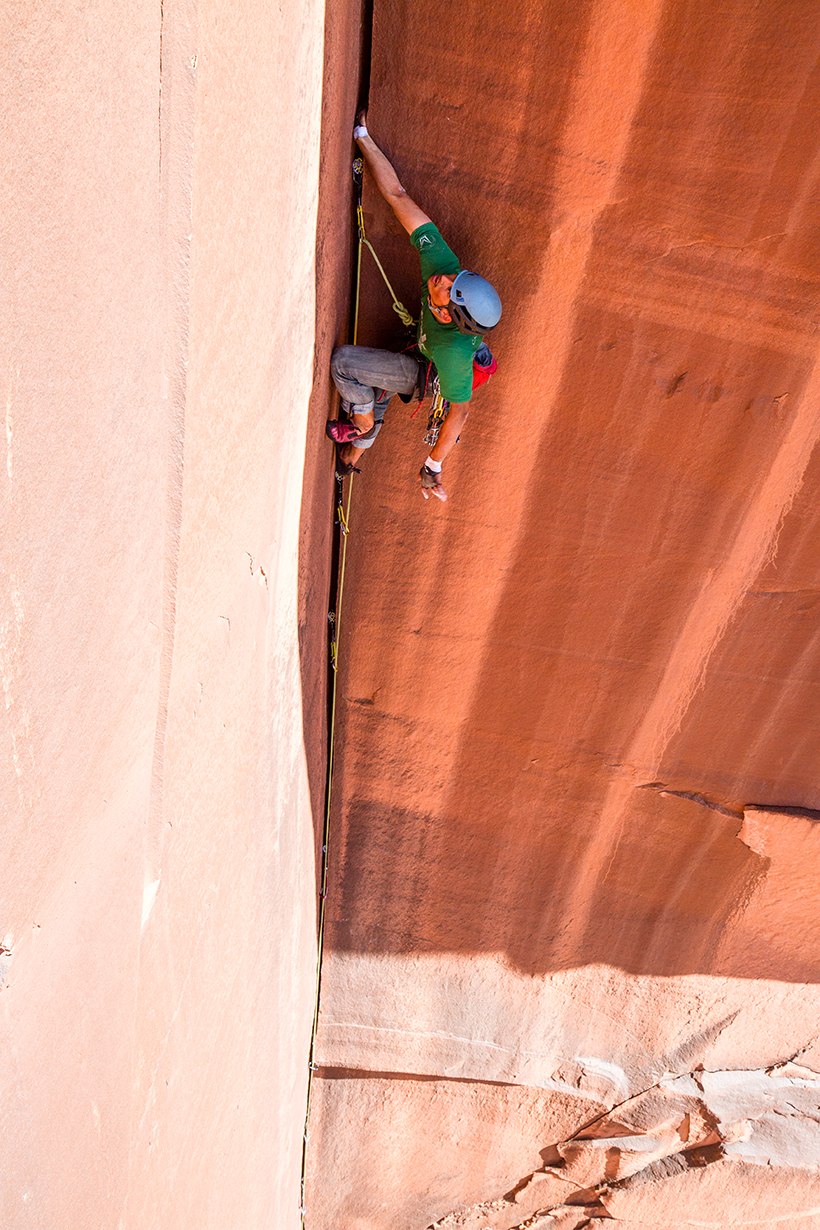
Mammut Wall Rider Helmet
Blister’s Measured Weight: 234 g (size 56-61cm)
Features:
- EPP core combined with a partial Hard Shell
- Ergonomic interior with comfortable padding
- Large ventilation openings for good air circulation and heat discharge
- Ultra-lightweight, minimalist adjustment system
- All-round, fully adjustable chin strap for ideal fit
- 2 clips at the front and a rubber loop on reverse side for fixing a headlamp
MSRP: $99
Days Tested: 80+
Test Locations: Mt. Rainier & North Cascades National Parks, WA; Chugach Range, AK; Wind River Range, WY; Cochise Stronghold, AZ; Indian Creek, UT; Fitz Roy Massif, Patagonia
Intro
For the past decade or so, climbing helmet design has been limited largely by materials — helmets were made of either hard plastic, rigid polystyrene foam, or a combination of both. While both materials make excellent helmets, both suffer drawbacks. Plastic is durable but heavy, while rigid foam is the exact opposite. And hybrid foam/plastic helmets generally feature a thin plastic outer shell with strategically placed foam inside.
The Mammut Wall Rider helmet takes the hybrid helmet design a step further with a more advanced foam and intentionally placed plastic.
A Little History on Materials & Climbing Helmets
The first climbing helmets used in the 1960’s were actually repurposed motorcycle helmets that were quickly redesigned into the “Joe Brown” helmet. The “Joe Brown” helmet was replaced by the hard shell plastic helmet (such as the Petzl Ecrin Roc) shortly thereafter.
In 1996, Petzl released the “Meteor,” the first Expanded Polystyrene (EPS) foam helmet. Since then, full EPS (Black Diamond Vapor) and EPS/plastic hybrid (Black Diamond Half Dome) styles have been the most popular helmets on the market. EPS is the same foam used in bike helmets, and it’s designed to absorb impact by breaking itself to dissipate force. This creates a helmet that is very lightweight, but can only take one major impact before it is compromised and needs to be replaced.
In 2013, Petzl changed the helmet game with the release of the Sirocco helmet, constructed entirely from Expanded Polypropylene (EPP) foam. EPP is different than polystyrene in that it has some “give” in the material. Additionally the Sirocco was (and still is) the lightest commercially available helmet.
The Mammut Wall Rider is the second helmet to utilize EPP foam, but unlike the Sirocco, it also has a plastic shell over part of the helmet.
Design
The Wall Rider looks like a cross between the Sirocco and a more traditional foam helmet like the Black Diamond Vapor. The EPP foam is exposed on the sides and back of the Wall Rider, while the forehead and top are shielded by a thin piece of plastic shell. The intention is to create a helmet shell resistant to front and top impacts, while still taking advantage of the material properties of EPP foam. The plastic shell also makes the Wall Rider more durable in high-wear areas.

Also, I know this is a personal aesthetics issue, but between the two EPP helmets on the market (the Wall Rider and the Sirocco) I much prefer the design of the Wall Rider. I’ve joked with friends that the Sirocco just looks uncomfortably phallic and the fact that it only comes in blaze orange doesn’t help the situation. The styling and color scheme on the Wall Rider is much more understated and neutral.
Additionally the Wall Rider is one of the lower-profile helmets I’ve worn. In the larger size (56-61cm, that is equivalent to the Black Diamond size M/L or the Petzl size 2), the Wall Rider is slimmer and sits lower on my head. The biggest advantage of the lower profile design is that it’s easier to put a hood on over the helmet; the lower profile allows a hood to stretch less, so you lose less flexibility when looking around.
Fit and Comfort
The Wall Rider does not have a plastic suspension and fit system. Instead, there is a series of thin webbing pieces which cradle the head. This shaves significant weight off the helmet, but it also makes adjusting the fit a more challenging and involved process. I was able to eventually get the helmet to fit comfortably, but it took a lot of fine-tuning over the course of several climbs. I’d strongly suggest fitting the helmet prior to leaving your vehicle, as the webbing is finicky and requires some patience and dexterity to adjust.
Once adjusted, though, I found the fit of the Wall Rider to be excellent. I tested the larger helmet that is sized to fit a 56-61 cm head. This is comparable to both Black Diamond and Petzl’s sizing; I wear a M/L in both other brands. The Wall Rider does come with two sets of foam pads of different thickness, so additional fine-tuning of the fit is possible.
Although I have never felt the urge to describe any helmet as “comfortable,” I would certainly not use the word “uncomfortable” to describe the Wall Rider. Between the large ventilation holes, low weight, and minimal suspension system, the Wall Rider is one of the more comfortable climbing helmets I’ve worn. The only drawback of the Wall Rider is that the suspension system is so minimal, wearing a baseball hat underneath the helmet is uncomfortable due to the foam sitting so close to your head. So if you want a brim to keep the sun off, I’d suggest either a visor underneath or a biking/running hat without a bead on top.
Head Coverage, Features, Etc.
